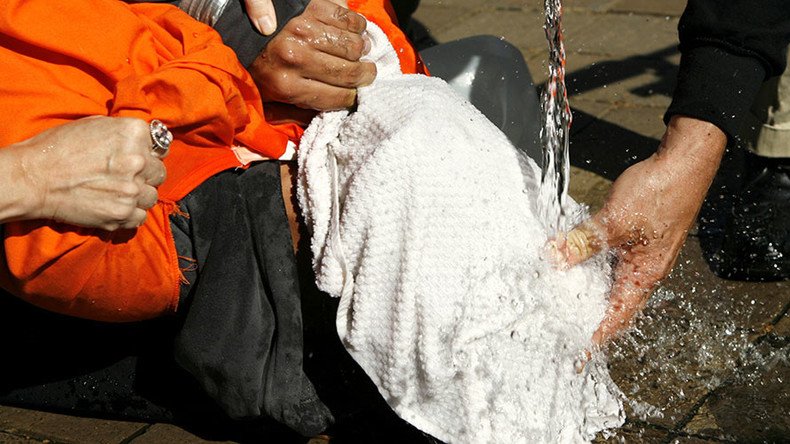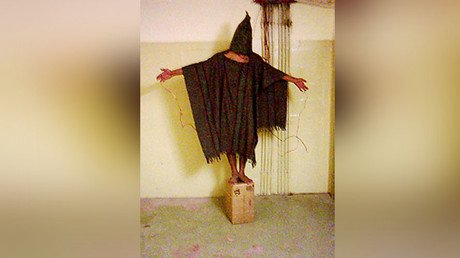CIA psychologists admit creating post-9/11 ‘torture’ practice for $81mn

Two former CIA psychologists have partially admitted to having advised torture and inhumane treatment for detainees, including those leading to fatalities. Over the course of some eight years, the CIA paid them $81 million for creating a torture program.
Both James Mitchell and Bruce Jessen admitted “in part” that they produced a document for the CIA called “Recognizing and Developing Countermeasures to Al-Qaeda Resistance to Interrogation Techniques: A Resistance Training Perspective.”
A 2015 lawsuit filed on behalf of three defendants accused both Mitchell and Jessen of designing, implementing and personally administering torture at a so-called CIA “black site.”
In their response to the case, the two psychologists admitted the CIA “sought and secured authorization” for what was later named “The Enhanced Interrogated Technique.”
Having denied any knowledge about two of the suing defendants ‒ Suleiman Abdullah Salim and Mohamed Ahmed Ben Soud ‒ Jessen and Mitchell partially admitted their roles in the fates of Abu Zubaydah and Gul Rahman. The latter froze to death in a CIA secret prison in Afghanistan in 2002 after being doused in water and left in a cage semi-naked in freezing temperatures.
The psychologists admitted that in April 2002 the CIA asked Mitchell “to provide real-time recommendations to overcome Zubaydah's resistance to interrogation.”
It was Mitchell who eventually advised the CIA to deny Zubaydah of any amenities. In the psychologist’s evaluation the subject “was withholding information.” Mitchell advised “his sleep be disrupted and that noise be fed into Zubaydah's cell,” including “rock music or other noise.”
For his part, Jessen on one occasion rolled up a towel behind Zubaydah's neck and "walled" him three or four times.
“Defendants admit that over a period of time, they administered to Zubaydah walling, facial and abdominal slaps, facial holds, sleep deprivation and waterboarding, and placed Zubaydah in cramped confinement,” Mitchell and Jessen’s lawyers said in the Response.
‘Mental torture’: #Gitmo inmate testifies against guards at US prison camp https://t.co/v0UoYDMAqk
— RT (@RT_com) June 3, 2016
A Saudi-born Palestinian, Zubaydah was subjected to 83 waterboarding sessions ‒ a torture technique akin to drowning – was placed in a coffin-sized box for a total of 266 hours (11 days, two hours) over a 20-day period, and forced to sit in another small confinement box 21 inches wide by 2.5 feet long for 29 hours.
Mitchell and Jessen have also partially admitted that Zubaydah, who spent nine years at Guantanamo without being charged, was stripped naked, confined and that his cell was lit by halogen lamps 24 hours a day for a period of time.
Months after the request to assist with Zubaydah, in November 2002 Jessen was asked to evaluate Rahman. The psychologist determined that the defendant was resistant and administered a facial slap to him.
“Defendants admit that Jessen observed Rahman being dragged down a hallway on one occasion and that such dragging appeared to result in abrasions to Rahman's legs,” Mitchell and Jessen’s lawyers wrote.
CIA-tortured Zubaydah called to testify against #Gitmo harsh techniques https://t.co/0cGWSZJQLXpic.twitter.com/8DG5BbvHQG
— RT (@RT_com) May 27, 2016
Despite their direct involvement, the psychologists said they “lack knowledge as to why the CIA did what it did” as well as about how many detainees were interrogated. At the same time, they added that “upon information and belief,” videotapes of the interrogations were destroyed.
Mitchell and Jessen also revealed that the CIA paid generously for their assistance in creating the torture program.
They admitted they received “taxable compensation of $1,800/day from the CIA” and that, through 2010, they were paid “approximately” $81 million.
“We have a clearly documented case of murder and it has not been prosecuted,” former CIA officer turned whistleblower John Kiriakou told RT. “Now we have this new information, new detail about the death of Gul Rahman, and no one in the Justice Department [is] doing anything about it. That’s not what this country should be about.”
Earlier in June, the CIA was forced to reveal more than 800 pages of post-9/11 torture evidence following a Freedom of Information Act (FOIA) request from the American Civil Liberties Union (ACLU).













